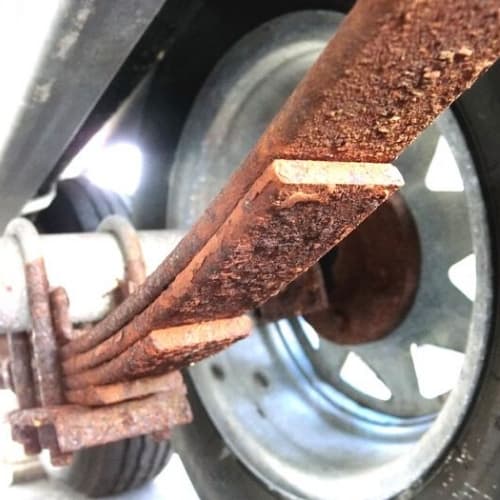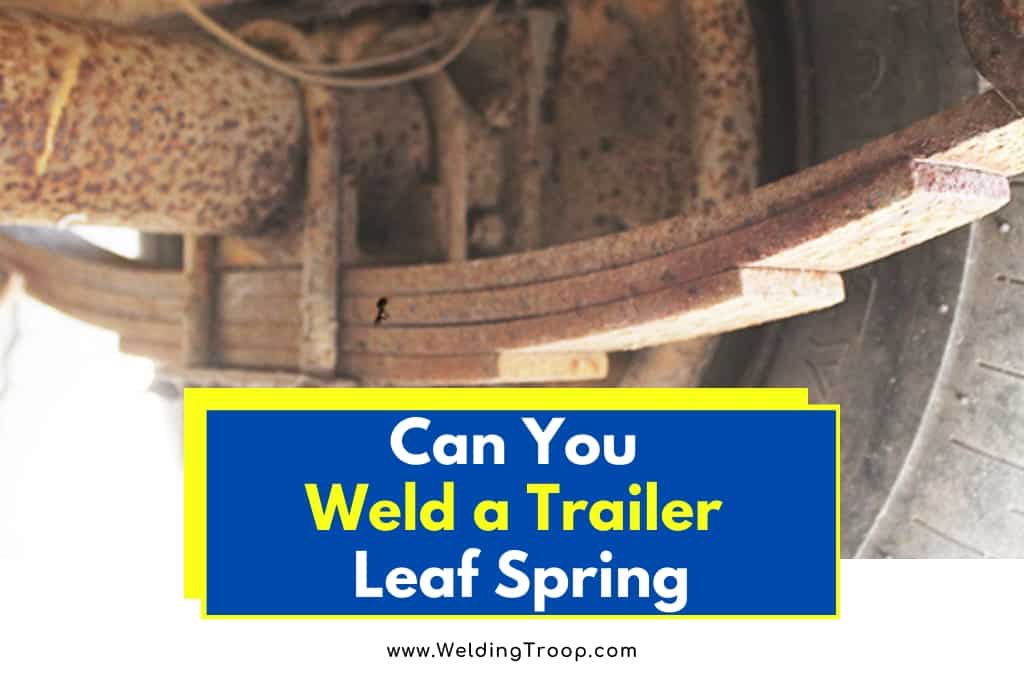You are here because you found an old trailer that you want to rehab to use as a utility trailer. A new trailer would break the bank account, but the one you have has a busted leaf spring. Is it possible to weld it, or are you going to have to dig into your wallet for a new spring?
Can you weld a trailer leaf spring? In most cases, you should not weld the leaf spring of a trailer. The increased heat during the welding process can create more damage to the spring, making them unsafe.
But that is not the end of the road on your route to having a functional trailer.
Table of Contents
Can You Weld a Leaf Spring For a Trailer?
Welding the leaf spring of a trailer is not recommended. Increased heat during the welding process can cause damage to the spring and make it unsafe for use. However, welding a leaf spring is technically possible under controlled environments.
If welding is necessary, it is recommended to weld all around the beam as this is deemed best from a strength perspective. Welding on the sides can cause “pull” issues and exacerbate any induced stress from bending at the factory, which can weaken the beam’s strength due to discontinuity in material properties.
Different welding processes and cleanup methods can also affect the strength of the weld. It is advised to follow safety precautions and not to weld the leaf springs if possible.
What Steel Is Used For Leaf Springs?
Leaf springs are typically made of high-strength steel, with Alloy Steel 5160 being a common choice due to its high tensile strength and ability to handle extreme stress.
Alloy Steel 5160 is a medium to high carbon steel with 0.6% carbon and 1% chromium in its composition, which makes it suitable for heavy-duty applications such as leaf springs.
The steel used in leaf springs is also commonly used in knife making where it is known for its toughness, wear resistance, and edge retention. Some sources suggest that leaf springs are made of low alloy or plain carbon steel with around 60 points carbon.
What Grade of Steel Is Spring Steel?
Spring steel is available in various grades, with some common ones being SAE 1074/1075 and SAE 1095 (A684). These grades are determined by their composition, yield strength, and hardness.
For example, SAE 1074/1075 has a hardness of 44-50 HRC, while SAE 1095 (A684) has a hardness of 60-75 HRC[2]. Spring steel can also be categorized based on their carbon content, such as low-alloy manganese, medium-carbon steel, or high-carbon steel.
The specific grade of spring steel used depends on the application and desired properties.
How Long Can I Drive On a Broken Leaf Spring?
Driving on a broken leaf spring is not recommended as it can cause problems with balance and pressure on the suspension system, leading to possible damage of tires and axles.
It is only safe to drive for short distances on flat roads or to a nearby garage to have the leaf spring replaced. If the broken piece is not the main leaf and there is no danger of it puncturing the tire, then it is possible to drive for a little while using a bungee to hold up the broken part.
However, it’s better to get it fixed soon as it can be dangerous. The lifespan of a leaf spring varies depending on its quality and environment, on average leaf springs can last about five to ten years in a saltwater environment.
When your Spring is Sprung
It isn’t difficult to notice when a trailer has a limp. If the tires are properly inflated, the most likely culprit is a leaf spring that has lost its bounce.
Leaf springs are designed to have an arch, or bow, to absorb stress from road bumps and provide a smoother ride. As weight is applied to a spring, the arch will flatten some to accommodate the weight. When a leaf spring doesn’t regain its normal arch when the weight is removed, you have a problem.
Basic Maintenance Checks
For trucks, you should inspect the springs around every 12,000 miles. On a trailer, you should perform an inspection prior to use for the season, or once every month with regular use.
A quick visual check involves viewing the truck or trailer from all sides. Things to look for:
- Does it sit level?
- Is the rear slightly raised (on dual-wheeled trailers)?
- Does one side sit lower than the other?
- Are springs visibly flattened?
To inspect your springs further, you will need to raise the vehicle or crawl under it. Placing the trailer on jack stands and removing the wheels is the easiest way to access the springs for a close inspection.

Start your inspection by using a wire brush or stiff nylon bristle brush to clean the leaf springs. The close inspection should be done with ample lighting:
- Are there visible chips or cracks on the edges of the leaves?
- Are all the leaves bent in the same arc with no light visible between them?
- Are the narrower leaves on the bottom poking the underside of the wider leaves above them?
- Is all the mounting hardware in good shape?
Make a note of pitting and rust, as these can be problems waiting to happen. Once you have completed a thorough inspection of your leaf springs and mounting hardware, you will be ready to make repairs if needed.
Safety First
Exercise proper safety precautions anytime that you perform maintenance on a vehicle or trailer. General precautions include:
- Use a jack and jack stands rated for the weight of the vehicle or trailer
- Wear gloves and safety glasses
- Don’t work alone, or at least have someone checking on you periodically
- Use adequate lighting to illuminate your work area
If you weld, be sure to follow the safety guidelines for your welding equipment and wear weld-safe clothing. While leaf springs are available at the auto parts store, there is only one of you.
Related Reading: Does Welding a Vehicle or a Truck Frame Weaken It? Is It Safe?
Simple Repairs for Mounting Hardware Problems
The most common failure in leaf springs is the mounting hardware that holds the spring in place. If your inspection turned up problems with mounting hardware, it should be repaired or replaced to avoid future damage to your springs.
Leaf springs are attached to the axle using U-bolts. Check them for wear, excessive rust, damaged threads, and proper torque on the nuts. Tighten or replace U-bolts as necessary. This is a relatively easy and inexpensive task that can add years to the life of your springs.
On some spring assemblies, the lowest leaf is not connected to the mounting clip but is held in place by the center-bolt. If the center-bolt is loose, the leaf can shift. To reposition it, whack it gently with a hammer to pop it back into place before tightening the center-bolt.
Mounting pads, bolts, and/or pins should be free of wear, rust, and other damage. Replace these as needed to avoid any instability in your leaf springs.
U-shaped clips attach the leaves to one another. These should be checked for visible fractures and wear. Worn or damaged clips should be replaced as necessary. Weak clips cause added stress to the leaf spring when traveling over rough roadways. This can cause the leaves to snap, leaving you stranded on your way to the lake.
Rubber dampers on mounting hardware should be clean and pliable. Check for signs of dry-rotting and replace them as needed. Dry-rotting most often occurs from sitting for long periods, so this problem is more prevalent on trailers following winter storage.
Welding What You Can Weld
As we stated earlier, it is not recommended that you attempt to weld a broken leaf spring. The biggest factor is that heat generated during welding can weaken the tensile strength of the steel.
While welding can be performed in some instances, most mechanics will recommend against it. Heating and cooling during welding can cause weak spots.
That said, welding leaf springs should only be performed in a controlled environment by a trained professional. The benefits of hiring this job out far outweigh the results, which could be catastrophic.

What you can weld is mounting brackets attached to the frame.
A general precaution though – remove the entire spring before welding to avoid any potential heating and cooling problems.
There are a few reasons for this recommendation:
- Metal conducts heat and may transfer to the leaves, causing damage.
- Welding creates slag, which could drop on a spring and cause damage.
- The weld will be stronger if performed without the tension of supporting the spring.
Because leaf springs are part of the suspension system, they are directly related to the overall safety of your vehicle or trailer. It is important to take care of them and keep them in tip-top condition.
The best way to ensure the integrity of your suspension system is to perform regular maintenance checks. Performing inspections and repairing the smaller, less expensive parts of the system will increase the life of your leaf springs.
When to Call a Professional or Replace Your Leaf Springs
Replacing leaf springs can be an expensive endeavor. As mentioned, preventative maintenance is your best method to prolong spring life and keep your trailer safe.
But if you do need to replace your springs, be sure to purchase the correct set for your vehicle or trailer.
Most part distributors will be able to help you determine the correct replacement parts.
Leaf springs can be reshaped to some degree to restore curve to flattened springs or remove curve to lower the center of gravity.
This process is more manual than technical, and we found a great video that outlines the process of reshaping leaf springs.
Leaf Spring Re-Arching >> Check the video below
Restoring an old set of leaf springs to replace bushings, retaining clips, wear pads, clean rust, and repainting is a simple but labor-intensive process.
If your springs are in good shape but need sprucing up, this video shows the process of restoring springs. Check out the video below
It is time to call in a professional if your leaf springs need welding. Otherwise, most repairs and maintenance can be done in your garage. Some special tools may be required, but many auto parts retailers have tool rental programs for a small fee.
Bouncy Springs Make a More Enjoyable Ride
Keeping your leaf springs in good shape isn’t as hard as you thought it was. Now that you know the basics of keeping the bounce in your truck or trailer, you are ready to pull out the tools.
Please remember to work safely. Keeping your leaf springs in good shape will protect your boat or your passengers from bumpy country roads.

